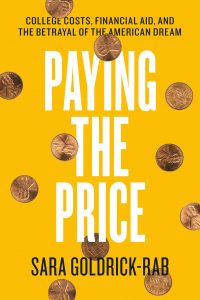Sara Goldrick-Rab: What Colleges Can Do Right Now

Sara Goldrick-Rab’s Paying the Price: College Costs, Financial Aid, and the Betrayal of the American Dream publishes this month and it isn’t hyperbole to claim it will soon become the definitive text on how higher education has let students down, as the cost of college continues to soar, while combinations of federal, state, institutional, and private aid fail to give students the resources they need to pay for it. In a recent piece for the Chronicle of Higher Education, Goldrick-Rab bluntly outlined five things she and her team of researchers learned (see below) in tracking 3,000 federal Pell Grant recipients enrolled in Wisconsin public universities through their college journeys. Hint: as Goldrick-Rab teases in the intro, the kids are most definitely not alright. You can read her piece in full here.
***
Here are five things we learned:
1. The way the federal government measures students’ financial need is misleading and even flat-out wrong. It overstates a family’s ability to pay for college by ignoring debt and the hardships that go with it, and grossly understates the actual costs of attending college.
2. Although colleges often expect families to financially support their children while they attend college, the reverse is happening — low-income children are supporting their parents, grandparents, and even siblings, all while being unable to buy their books.
3. Against a backdrop of increasingly fancy residence halls and sushi bars in campus cafeterias, a significant fraction of students are going without sufficient food or housing.
4. Working in college is an American tradition. But 2016 is not 1975. Many students without jobs are searching for work they can’t find. Others are holding down two or even three minimum-wage jobs to try to make enough, and too many students are working the graveyard shift because it pays more, going from work straight to class without a night’s sleep.
5. Loans are supposed to let students afford college now, focus on their studies, and pay the piper later — but that’s often not how they work in reality. Loans affect students long before they come due. With prices at an all-time high, taking a loan for college has become a necessity rather than a choice. Yet the prospects of graduating from college, let alone getting a good job afterward, are uncertain.
Feeling forced into borrowing is contributing to stress during college. To make money through work and minimize their loan exposure, students sacrifice participation in the sorts of academic and social activities that build networks and learning, the kinds of activities that increase the economic returns of their degrees. And yes, it contributes to resentment and distress when the loans must be repaid.
These are the new economics of college — and they are harsh.
To read more about Paying the Price, click here.